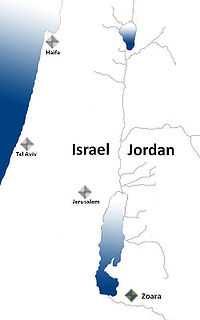Zoara

Zoara, the biblical Zoar, previously called Bela, (Genesis 14:8,) was one of the five (Pentapolis) cities of the plain of Jordan[1] in Genesis in the Tanakh or Old Testament, which escaped the "brimstone and fire" which destroyed Sodom and Gomorrah, for having sheltered Lot and his daughters.[2] It is mentioned by Josephus;[3] Ptolemy (V, xvi, 4); and by Eusebius and Saint Jerome in the Onomasticon.
Zoara is also a Roman Catholic titular see of Palestina Tertia.
In the Bible
Zoara-, meaning "small" or "insignificance" in Hebrew, (a "little one" as Lot called it,) was a city east of Jordan in the vale of Siddim, which later became the Dead Sea. Along with Sodom, Gomorrah, Admah, and Zeboim, Zoar was one of the 5 cities slated for destruction by God; but Zoar was spared at Lot's plea as his place of refuge. (Genesis 19:20-23)
Zoara in recent centuries
Several excavation surveys have been conducted in this area in the years 1986-1996. Ruins of a Basilical church that were discovered in the site of Deir 'Ain 'Abata ("monastery at the Abata Spring" in Arabic), were identified as the Sanctuary of Agios (Saint) Lot. An adjacent cave is ascribed by Christians as the location where Lot and his daughters took refuge during the overthrow of Sodom. About 300 engraved funerary steles in the Khirbet Sheikh 'Isa area in Ghor al-Safy were found in 1995. Most gravestones were inscribed in Greek and thus attributed to Christian burials, while several stones were inscribed in Aramaic, hinting that they belong to Jewish burials. These gravestones were therefore traced back to the 4th-5th centuries AD, when Zoara was an important Jewish center.[citation needed]
The Notitiae Dignitatum, 72, places at Zoara, as a garrison, the resident equites sagitarii indigenae; Stephen of Byzantium (De urbibus, s.v. Addana) speaks also of its fort, which is mentioned in a Byzantine edit of the 5th century (Revue biblique, 1909, 99). In a Madaba Map, of the 6th century, it is represented in the midst of a grove of palm trees under the names of Balac or Segor, now Zoara; near the city is a sanctuary to St. Lot. Hierocles (Synecdemus) and George of Cyprus[4] both mention it.
Bishops at Zoara
Some bishops have been ascribed to Zoara;
- Musonius, at Ephesus (449), and at Chalcedon (451);
- Isidore in 518;and
- John in 536.[5]
At the end of the 4th century one of its bishops accompanied the western pilgrim, wrongly named Silvia.[6] The pseudo-Antonius in the 6th century describes its monks, and extols its palm trees (op. cit., 166, 181). Owing to its tropical climate and to the waters coming down from the mountains of Moab, Zoara is a flourishing oasis where the balsam, indigo, and date trees bloom luxuriantly. During the French occupation it took the name of Palmer, or of Paumier.[citation needed]
Other references to Zoara
The Syriac Chronicles of Michael the Syrian (12th century) and of Bar Hebraeus (13th century) contain some obscure traditions regarding the founding of some of the "cities of the plain". According to these accounts, during the lifetime of Nahor (Abraham's grandfather), a certain Canaanite named Armonius had two sons named Sodom and Gomorrah, for whom he named two newly built towns, naming a third (Zoara) after their mother.
William of Tyre (XXII, 30) and Foulcher of Chartres (Hist. hierosol., V) have left beautiful descriptions of it, as well as the Arabian geographers, who highly praise the sweetness of its dates.[7] It is not known when the city disappeared; it is now very difficult to find any traces of it. Search may be made in the Ghor-es-Safieh at the mouth of Wadi el-Qrahy, the ancient torrent of Zared.[citation needed]
Archeology
Prior to the major archeological excavations in the 1980s and 1990s that took place in Zoara, scholars proposed that several sites in the area of Khirbet Sheikh 'Isa and al-Naq' offered further evidence of Zoara's location and history. Further information regarding Zoara in different historical epochs were obtained through the descriptions of Arabian geographers, suggesting that Zoara served as an important station in the Akkabah-to-Jericho trade route, and through Eusebius's statement that the Dead Sea was situated between Zoar and Jericho. Researchers who have studied ancient texts portray Zoara as a town erected in the middle of a flourishing oasis, watered by rivers flowing down from the high Moab Mountains in the east. The sweet dates that grew abundantly on the palm trees surrounding Zoara are also mentioned in some historical texts.[citation needed]
Notes
- ↑ Genesis 14:2-8
- ↑ Genesis 19:22-30
- ↑ Ant. Jud., XIII, xv, 4; Bell. Jud., IV, viii, 4
- ↑ Description of the Roman World
- ↑ Le Quien, Oriens christianus, III, 737-746.
- ↑ Geyer, Itinera hierosolymitana, 54
- ↑ Guy Le Strange, Palestine under the Moslems, 289
| Wikisource has the text of the 1913 Catholic Encyclopedia article Zoara. |
![]() This article incorporates text from a publication now in the public domain: Herbermann, Charles, ed. (1913). Catholic Encyclopedia. Robert Appleton Company.
This article incorporates text from a publication now in the public domain: Herbermann, Charles, ed. (1913). Catholic Encyclopedia. Robert Appleton Company.
Coordinates: 31°02′49″N 35°30′09″E / 31.04694°N 35.50250°E